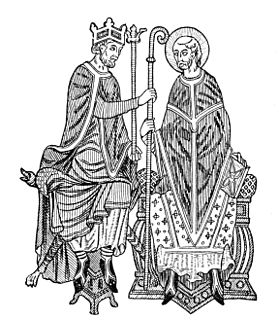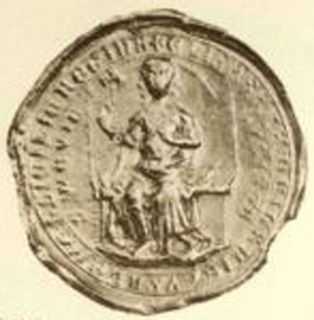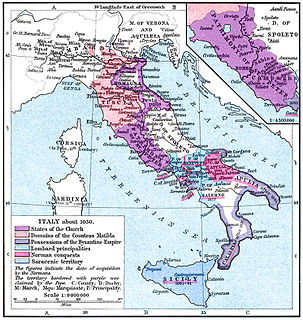Albert II (German : Adalbert; died about 1125) was a progenitor of the Albertine House of Tyrol. He was documented as a count ruling the Bavarian estates in the Inn, Wipp and Eisack valleys of the Eastern Alps.

German is a West Germanic language that is mainly spoken in Central Europe. It is the most widely spoken and official or co-official language in Germany, Austria, Switzerland, South Tyrol (Italy), the German-speaking Community of Belgium, and Liechtenstein. It is also one of the three official languages of Luxembourg and a co-official language in the Opole Voivodeship in Poland. The languages which are most similar to German are the other members of the West Germanic language branch: Afrikaans, Dutch, English, the Frisian languages, Low German/Low Saxon, Luxembourgish, and Yiddish. There are also strong similarities in vocabulary with Danish, Norwegian and Swedish, although those belong to the North Germanic group. German is the second most widely spoken Germanic language, after English.

The (Princely) County of Tyrol was an estate of the Holy Roman Empire established about 1140. Originally a jurisdiction under the sovereignty of the Counts of Tyrol, it was inherited by the Counts of Gorizia in 1253 and finally fell to the Austrian House of Habsburg in 1363. In 1804 the Princely County of Tyrol, unified with the secularised Prince-Bishoprics of Trent and Brixen, became a crown land of the Austrian Empire in 1804 and from 1867 a Cisleithanian crown land of Austria-Hungary.

The Duchy of Bavaria was a frontier region in the southeastern part of the Merovingian kingdom from the sixth through the eighth century. It was settled by Bavarian tribes and ruled by dukes (duces) under Frankish overlordship. A new duchy was created from this area during the decline of the Carolingian Empire in the late ninth century. It became one of the stem duchies of the East Frankish realm which evolved as the Kingdom of Germany and the Holy Roman Empire.
Albert inherited the Alpine lordships from his father, Count Albert I (d. about 1100), who descended from Eurasburg (Iringsburg) in Upper Bavaria. He had been a loyal supporter of King Henry IV during the fierce Investiture Controversy, in opposition to Duke Welf of Bavaria. In turn, the king vested him with wide-ranging autonomy upon Welf's deposition in 1077.

Eurasburg is a municipality in Oberbayern. It is situated about 40 kilometres south of the Bavarian state capital, Munich, in the county of Bad Tölz-Wolfratshausen.

Henry IV became King of the Germans in 1056. From 1084 until his forced abdication in 1105, he was also referred to as the King of the Romans and Holy Roman Emperor. He was the third emperor of the Salian dynasty and one of the most powerful and important figures of the 11th century. His reign was marked by the Investiture Controversy with the Papacy, and he was excommunicated five times by three different popes. Civil wars over his throne took place in both Italy and Germany. He died of illness, soon after defeating his son's army near Visé, in Lorraine, France.

The Investiture Controversy or Investiture Contest was a conflict between church and state in medieval Europe over the ability to appoint local church officials through investiture. By undercutting imperial power, the controversy led to nearly 50 years of civil war in Germany. According to historian Norman Cantor, the investiture controversy was "the turning-point in medieval civilization", marking the end of the Early Middle Ages with the Germanic peoples' "final and decisive" acceptance of Christianity. More importantly, it set the stage for the religious and political system of the High Middle Ages.
Albert II married Adelaide (d. about 1153), a daughter of Count Berthold of Dießen-Andechs. His sons Albert III (d. 1165) and later, Berthold I succeeded him as Counts of Tyrol.

The House of Andechs was a feudal line of German princes in 12th and 13th century. The Counts of Dießen-Andechs obtained territories in northern Dalmatia on the Adriatic seacoast, where they became Margraves of Istria and ultimately dukes of a short-lived imperial state named Merania from 1180 to 1248.
Berthold I was Count of Tyrol from about 1165 until his death.
Under Albert II, the construction of Tyrol Castle began in the early 12th century. The ancestral seat was finished during 1160, under the direction of his younger son, Count Berthold I. [1]

Tyrol Castle, less commonly Tirol Castle is a castle in the comune (municipality) of Tirol near Merano, in the Burggrafenamt district of South Tyrol, Italy. It was the ancestral seat of the Counts of Tyrol and gave the whole Tyrol region its name.













